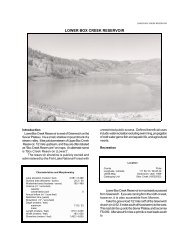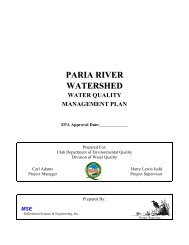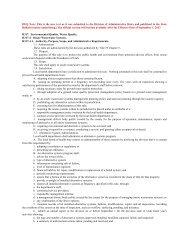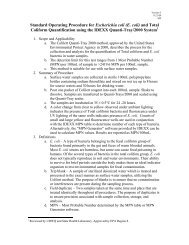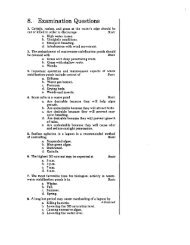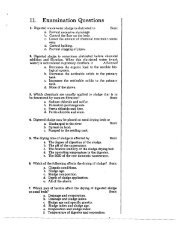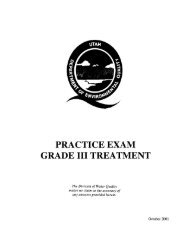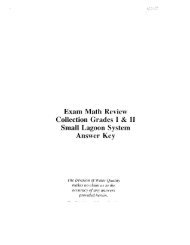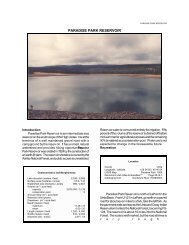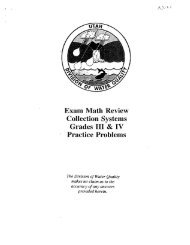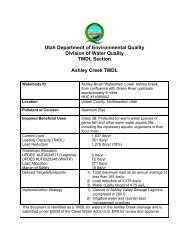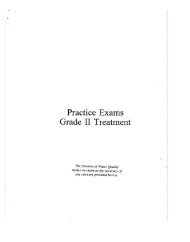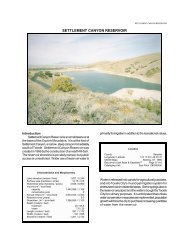Aquifer Recharge, Storage, and Recovery - Southwest Hydrology ...
Aquifer Recharge, Storage, and Recovery - Southwest Hydrology ...
Aquifer Recharge, Storage, and Recovery - Southwest Hydrology ...
- No tags were found...
Create successful ePaper yourself
Turn your PDF publications into a flip-book with our unique Google optimized e-Paper software.
Water Quality Changes During Subsurface <strong>Storage</strong>Peter Fox – Arizona State UniversityWhile underground storage ofwater offers many benefits,transformations in waterquality resulting from the recharge ofone type of water into an aquifer ofdifferent composition warrant attention.The primary constituents of concern thatmay be introduced into or form in storagesystems include organics <strong>and</strong> pathogens;nutrients <strong>and</strong> inorganics can also causeproblems. These constituents may bebroken down, mitigated, or otherwisechanged through chemical, biological,adsorption, dilution, or filtration processesthat take place in the storage zone. Theextent to which these processes occurdepends on the compositions of the twowater types <strong>and</strong> the subsurface conditions.Time, Surface Area Are FactorsSome water quality transformations occurrapidly, such as those that result fromchanges in oxidation-reduction (redox)conditions or chemical interactionsbetween the injected water <strong>and</strong> the aquifer.These reactions may not only changethe water quality but also impact thehydraulic capacity of injection wells.Other transformations, such as thebiodegradation of trace organiccompounds, often occur slowly; sufficienttime is required to achieve the full benefitsof aquifer storage. For7.0example, with enoughtime, natural attenuation6.0processes can improve5.0the quality of storedwater to that approaching 4.0native groundwater.DOC (mg/L)Alluvial aquifers, comprisedmostly of s<strong>and</strong> <strong>and</strong> gravel,contain abundant surfacearea, which permits plentyof contact with the watertraveling through it. Thissurface area mediates manybiogeochemical reactions thatcan improve water quality. Suchwater quality transformationsare less likely in fractured <strong>and</strong>3.02.01.00.024 • May/June 2008 • <strong>Southwest</strong> <strong>Hydrology</strong>karst aquifers where preferential flowthrough cracks <strong>and</strong> fissures limits contactbetween the water <strong>and</strong> aquifer material.A select group ofSOCs has beenfound to persist inthe subsurface, <strong>and</strong>the list is growing.Flowpaths also affect transformationsduring subsurface storage. Flowpathssurrounding dual-purpose wells—usedfor both injection <strong>and</strong> recovery—havehighly variable travel times <strong>and</strong> themost unpredictable effects on waterquality. Subsurface storage systemswith different recharge <strong>and</strong> recoverypoints can have defined flowpaths <strong>and</strong>associated travel times. Such systemshave more consistent <strong>and</strong> predictablewater quality transformations.Oxygen Matters AlsoMany organics, nutrients, <strong>and</strong> pathogens ofconcern can be removed in the subsurfacethrough biological mechanisms. Keyfactors that affect biological removalduring subsurface storage include thebiodegradable organic carbon content of0 2000 4000 6000 8000 10000 12000 14000 16000Distance downgradient (feet)Dissolved organic carbon (DOC) concentration is shown as afunction of distance for the Mesa (Arizona) Northwest WaterReclamation Plant groundwater recharge basins. Each 1,000 feetof travel equals around six months of travel time. After severalyears of travel, DOC concentrations are less than 1 milligram perliter, approaching background conditions of the aquifer.the recharge water <strong>and</strong> redox conditionsof the aquifer. Therefore reverse-osmosistreatedwater, lacking organic carbon,does not support significant biologicalremoval. In fact, trace constituents suchas N-nitrosodimethylamine (NDMA)have been shown not to attenuate duringthe injection of reverse-osmosis-treatedwater, unlike in other recharge systems.Most biological transformations will occurwhether or not oxygen is present, however,some organic compounds require a specificelectron acceptor to degrade. Manychlorinated organic compounds, such astrihalomethanes, degrade faster underconditions where oxygen is low or absent.Finally, recharging waters high in oxygendem<strong>and</strong> will create anoxic conditions <strong>and</strong>increase the potential for the dissolutionof mineral iron <strong>and</strong> manganese.The Organic PlayersThree types of residual organic materialsundergo transformation: natural organicmatter (NOM), which is present inmost water supplies; soluble microbialproducts (SMPs) formed during thewastewater treatment process from thedecomposition of organic compounds,<strong>and</strong> synthetic organic compounds (SOCs)added by consumers <strong>and</strong> also generatedas disinfection byproducts (DBPs) duringwater <strong>and</strong> wastewater treatment(Barker <strong>and</strong> Stuckey, 1999).Most waters contain NOM; reclaimedwaters contain a mixture of NOM<strong>and</strong> SMPs. NOM <strong>and</strong> SMPsmeasured together as dissolvedorganic carbon have concentrationstypically measured in the milligramsper liter range. The primary concernover NOM <strong>and</strong> SMPs is theirpotential to form DBPs <strong>and</strong> stimulatebiological growth in distributionsystems. Concerns over bothhuman <strong>and</strong> aquatic health effectsare generally associated with SOCs<strong>and</strong> DBPs, which are measuredindividually at concentrations ofmicrograms or nanograms per liter.




